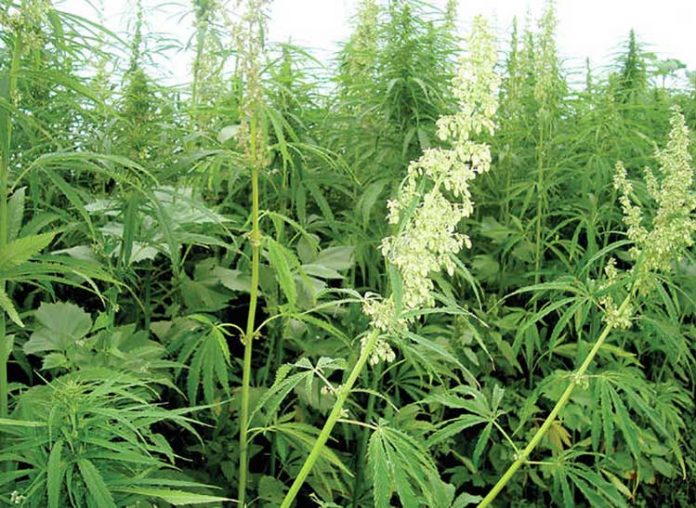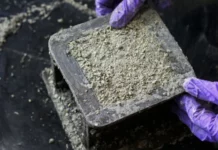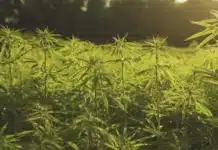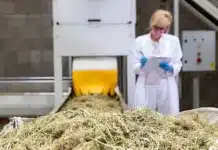Blowing snow and sub-zero temperatures didn’t stop more than 80 people from traveling the roads of western Minnesota Thursday, Jan. 11, to reach the aptly-named Frozen Farm Forum in Madison.
They braved the weather to learn about the possibility of raising industrial hemp in Minnesota. Their interest came as no surprise to Margaret Wiatrowski, coordinator of the industrial hemp program for the Minnesota Department of Agriculture. The forum marked the fourth big event she’s spoken at this year, each with large crowds.
“Astonishing,” said Wiatrowski. “I can’t believe how many people are really fired up about growing hemp.”
The interest is well founded, according to keynote speaker Robert Mitchell, founder of The Hemp Connection in Tulsa, Oklahoma. It is working to develop the infrastructure needed to process industrial hemp in this country, something that has not happened since hemp was raised as part of the war effort in the 1940s.
Mitchell said hemp can be made into 30,000 different products, from textiles and paper to biofuels. Its use as a food product — its seeds contain 33 percent protein — is believed to represent the biggest market currently.
“The economic benefits are too great to ignore,” said Mitchell. He pointed out that 90 percent of the hemp now legally sold in the U.S. is imported from Canada. “We should be growing our own,” he said.
It’s possible to do so now because Minnesota is among the states offering a pilot program under a 2014 federal law. It allows growers to raise hemp to study its growth, cultivation and marketing. Six growers planted 38 acres in 2016 when the state started the pilot program. Last year, 33 growers raised hemp on 1,205 acres, according to Wiatrowski.
The growers were widely distributed around the state, she said.
Industrial hemp and marijuana are members of the same, cannabis sativa plant species. Industrial hemp must contain less than 0.3 percent of tetrahydrocannabinol, or THC, the mood altering ingredient found in marijuana. Those licensed to raise industrial hemp under the state program must be fingerprinted, undergo a criminal background check, and can only plant certified, industrial hemp seeds.
The Department of Agriculture tests the fields to assure that the hemp meets the 0.3 percent THC standard. Wiatrowski said all of the growers met it last year, with samples showing an average of 0.115 percent THC, or well below the threshold.
Results from last year’s pilot program show that grain yields ranged from 250 pounds per acre to 2,200 pounds per acre, with the average at 1,300 pounds. “A huge range,” noted Wiatrowski.
Wiatrowski said she believes the difference in productivity can largely be attributed to the different experience levels of the growers. Some of the participants had very little farming experience, while others were experienced, conventional farmers.
Still, Wiatrowski and growers who participated in the pilot program cautioned that raising hemp poses challenges, even for those with lots of experience in farming. Participants reported issues with weeds, aphids and other pests, herbicide sensitivity, and harvesting. The seeds can easily shatter and spoil quickly if not dried immediately after harvest. Birds love the seeds and will descend on fields.
And know this: The stalks are tough and make combining a slow and difficult process, said John Dinse, who farms in the Owatonna area, and Bryan Biegler, who farms near Lake Wilson.
Participants said there is a need for a commercial processor that can clean and bring the seed to the 99 percent purity level required for sale as human food.
Wiatrowski also pointed out that participants must be mindful of federal laws if they want to ship their product out of Minnesota. Being licensed as a grower in the state’s pilot program does not offer any legal immunity. “Ultimately, if something happens outside of our state there is nothing we can do about it,” she said.
Despite these challenges, Wiatrowski said she expects interest in the pilot program to continue to grow. The state is now opening up the application period for 2018.
The interest might be explained by the reasons last year’s participants gave when surveyed. Wiatrowski said growers said they were not making money on corn and soybeans and were looking for a more profitable option, as well as crop rotation opportunities. They also cited interests in exploring markets for food and oils from industrial hemp.
And yes, there were a few who originally applied to the pilot program who told her that they did so to gain experience in the hope that someday marijuana can be raised legally, Wiatrowski told the Tribune.














